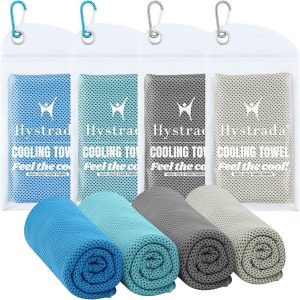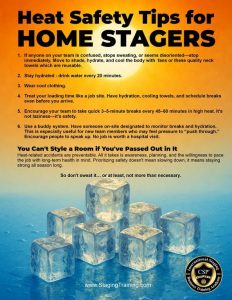How to Prevent Heat-Related Accidents While Staging This Summer
Home staging might look glamorous online, but those of us who do it for a living know it’s also physical labor, furniture, packing, inventory control, and sometimes hauling boxes in and out of homes often with no AC.
In the heat of summer, those everyday tasks can become safety hazards.
Heat-related illness isn’t just something that happens to road workers and roofers. When you’re moving quickly to meet deadlines, working in vacant properties, and spending time in hot trucks or unventilated homes, your body can hit its limit without much warning. Let’s take a closer look at what heat-related accidents can look like on the job—and what you can do to prevent them.
What’s at Risk? Accidents Caused by Extreme Heat
Heat doesn’t just make you uncomfortable. It can affect your body, your brain, and your performance. Here’s how it shows up on the job:
1. Heat Exhaustion and Heat Stroke
The most serious risk. Symptoms of heat exhaustion include heavy sweating, dizziness, weakness, nausea, and headache. If untreated, this can escalate to heat stroke, which requires emergency medical attention.
 Common triggers for stagers:
Common triggers for stagers:
- Setting up in a vacant home with no fans or AC
- Working in direct sunlight or near large windows
- Skipping breaks because you’re “just trying to finish the job”
Safety tip: If anyone on your team is confused, stops sweating, or seems disoriented—stop immediately. Move to shade, hydrate, and cool the body with fans or these quality neck towels which are reusable.
2. Reduced Focus and Mental Fog
Your brain function takes a hit in extreme temperatures. This leads to:
- Missed steps in your staging plan
- Forgetting items in the truck
- Miscommunication with clients or team members
Even a small drop in concentration can turn into a big mistake, like dropping an expensive lamp or damaging a wall while rushing to unload.
3. Slips, Trips, and Muscle Strain
Excessive sweating makes your hands slippery. Heat causes fatigue. You’re more likely to:
- Misjudge your strength
- Stumble while lifting
- Drop furniture or slip while carrying boxes upstairs
Even experienced stagers become more accident-prone when heat is involved.
4. Truck and Warehouse Heat Exposure
Loading and unloading trucks in peak sun (or working inside a hot storage unit) is dangerous. Some trucks become ovens on wheels. Overexertion and dehydration can sneak up quickly, especially if the job is time sensitive.
Pro tip: Treat your loading time like a job site. Have hydration, cooling towels, and schedule breaks even before you arrive.
5. Working in Vacant Homes Without Airflow
Homes without AC or fans trap heat. These “stale air” environments can become unbearably hot even before midday.
Be cautious of:
- Steaming bedding in a sealed room
- Standing in direct sunlight from large south-facing windows
- Long consultations where you’re walking from room to room without ventilation
Preventive Strategies: Staying Safe Without Slowing Down
You don’t have to shut down business in the summer, just be smarter with your time, your setup, and your planning.
1. Time Your Work Intentionally
- Can you adjust timing to install early in the morning or evening
- Avoid mid-day when interior heat peaks
- Schedule walk-throughs or consults in cooler hours
2. Hydrate, Fuel, and Cool Down
- Keep cold water, Gatorade, or electrolyte packets on hand
- Pack cold snacks like fruit, protein bars, or ice packs
- Use cooling towels on your neck between rooms
Encourage your team to take quick 3–5-minute breaks every 45–60 minutes in high heat. It’s not laziness, it’s safety.
3. Dress for the Job
- Lightweight, breathable fabrics
- Hats or visors if outdoors
- Light-colored shoes with grip (not bare feel, flip flops or sandals!)
If you’re wearing branding, consider lighter fabric logo tees just for summer months.
4. Prep Clients (and Agents) in Advance
Let clients know:
- AC needs to be turned on a full hour prior to arrival
- Certain staging tasks may be adjusted based on heat
- You’ll be on site only for a set period to ensure crew safety
This sets expectations, avoids complaints, and shows professionalism.
5. Watch Your Team (and Yourself)
Use a buddy system. Have someone on-site designated to monitor breaks and hydration. This is especially useful for new team members who may feel pressure to “push through.” Encourage people to speak up. No job is worth a hospital visit.
Heat Safety = Business Professionalism
If you’re running a proper business—not just a hobby—you need to consider risk management. That includes heat. A safe, prepared crew is a productive one. When clients see you managing safety with care and intention, it builds credibility.
Make it part of your summer system:
• Create a heat safety checklist download ours
• Include it in your job prep or staging logistics brief
• Review it during team meetings
You Can’t Style a Room if You’ve Passed Out in It
Heat-related accidents are preventable. All it takes is awareness, planning, and the willingness to pace the job with long-term health in mind. Prioritizing safety doesn’t mean slowing down, it means staying strong all season long.
So don’t sweat it… or at least, not more than necessary.
Download our Heat Safety Tips for Home Stagers. Post it everywhere as a reminder for your team.
















 Subscribe Today!
Subscribe Today! 


